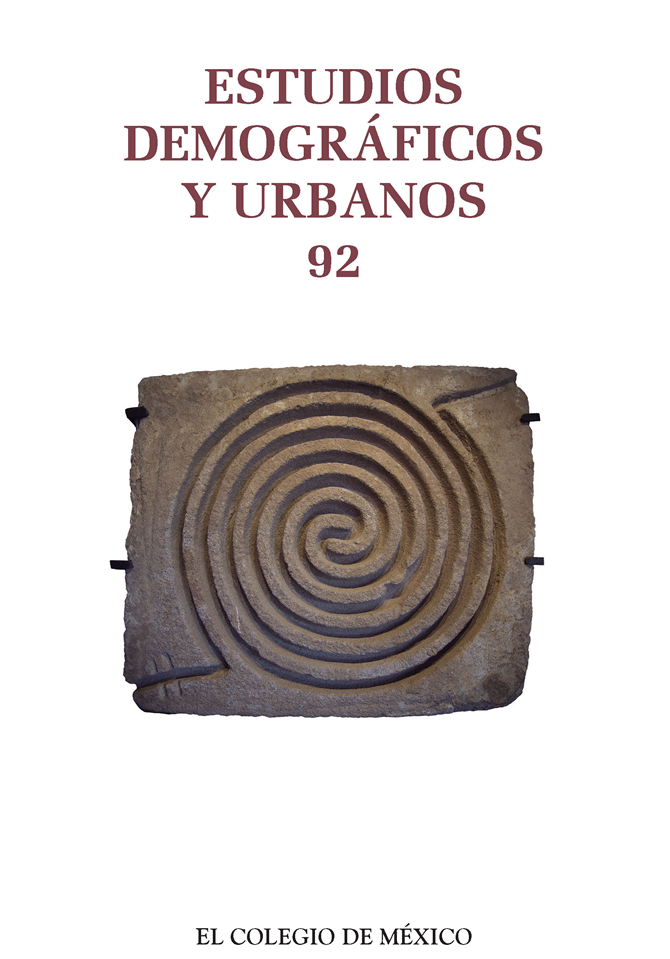Published 2016-05-01
Keywords
- urban labor market,
- creative class,
- cities concentrating the creative class
How to Cite
-
Abstract1265
-
PDF (Español)590
-
En línea (Español)1186
Downloads
Copyright (c) 2016 Estudios Demográficos y Urbanos

This work is licensed under a Creative Commons Attribution-NonCommercial-NoDerivatives 4.0 International License.
Metrics
Abstract
The purpose of this document is to conduct an exploratory study of the demographic and economic attributes of cities in Mexico where the creative class is concentrated, in other words, the sector of the urban labor market comprising professionals, university professors, researchers, and those engaged in the arts, entertainment and sports. The term “creative class” was coined by Richard Florida (2002) and this segment of the working population has been given a connotation of competitive advantage for the city where it lives. Accordingly, attempts have been made to test the link between local economic performance and the presence of the creative class. This study, however, does not use the creative class as an explanatory variable of local economic behavior. Instead, it seeks to shed light on the characteristics of the cities with the greatest intensity of the creative class in its occupational structure. To this end, a multivariate logistic regression model was designed. The results show that cities where the creative class was concentrated in 2010 were mainly state capitals and/or with a low share of manufacturing output in their economic structure. Likewise, those engaged in the creative class had a higher rate of internal migration with regard to the total working population. The places of origin and destination of creative migration were cities specializing in this type of employees.
References
- Aguilar, G. y C. Alvarado (2004), “La reestructuración del espacio urbano de la Ciudad de México: ¿hacia la metrópoli multimodal?”, en G. Aguilar (coord.), Procesos metropolitanos y grandes ciudades, México, Universidad Nacional Autónoma de México / Miguel Ángel Porrúa, pp. 265-307.
- Danielsen, Karen A. y Robert E. Lang. (2005), “Review roundtable: cities and the creative class”, Journal of The American Planning Association, vol. 72, núm. 2, pp. 206-218. Disponible en: http://digitalscholarship.unlv.edu/sea_fac_articles/285/ (17 de marzo de 2015).
- Bluestone, B., M. Stevenson y R. Williams (2008), The Urban Experience, Oxford, Oxford University Press.
- Coe, N., P. Kelly y H. Yeung (2013), Economic Geography. A Contemporary Introduction, Nueva York, John Wiley and Sons.
- Coffey, W. y R. Shearmur (2002), “Agglomeration and dispersion of high-order service employment in the Montreal Metropolitan Region, 1981-1996”, Urban Studies, vol. 39, núm. 3, pp. 359-378. Disponible en: http://usj.sagepub.com/content/39/3/359.full.pdf+html (13 de mayo de 2015). DOI: https://doi.org/10.1080/00420980220112739
- Dannhaeuser, N. (1985), “Urban market channels under conditions of development: the case of India and Philippines”, en S. Plattner (comp.), Markets and Marketing, Lanham, University Press of America, pp. 179-203.
- Donegan, M., J. Drucker, H. Goldstein, N. Lowe y E. Malizia (2008), “Which indicators explain metropolitan economic performance best? Traditional or creative class”, Journal of The American Planning Association, vol. 74, núm. 2, pp. 180-195. Disponible en: http://www.tandfonline.com/doi/abs/10.1080/01944360801944948 (15 de marzo de 2015). DOI: https://doi.org/10.1080/01944360801944948
- Duranton, G. y D. Puga (2000), “Diversity and specialisation in cities: Why, where and when does it matter?, Urban Studies, vol. 37, núm. 3, pp. 533-555. Disponible en: http://usj.sagepub.com/content/37/3/533.full.pdf+html (17 de marzo de 2015). DOI: https://doi.org/10.1080/0042098002104
- Florida, R. (2002), The Rise of the Creative Class, Nueva York, Basic Books.
- Florida, R. (2005), Cities and the Creative Class, Nueva York, Routledge. DOI: https://doi.org/10.4324/9780203997673
- Gilbert, A. (1994), “Third World cities: poverty, employment, gender roles and environment during a time of restructuring”, Urban Studies, vol. 31, núms. 4/5, pp. 605-633. Disponible en: http://usj.sagepub.com/content/31/4-5/605.full.pdf+html (13 de mayo de 2015). DOI: https://doi.org/10.1080/00420989420080601
- Goodall, B. (1987), Dictionary of Human Geography, Londres, Penguin Books.
- Hirsch, W. (1973), Análisis de economía urbana, Madrid, Instituto de Estudios de Administración Local.
- ILO (2015), Laborsta. Database of Labour Statistics, Ginebra, International Labour Organization <http://www.ilo.org/stp/guest> (29 de junio de 2015).
- Keyfitz, N. (1980), “Do cities grow by natural increase or by migration?”, Geographical Analysis, vol. 12, núm. 2, pp. 142-156. Disponible en: http://onlinelibrary.wiley.com/doi/10.1111/j.1538-4632.1980.tb00024.x/pdf (29 de junio de 2015). DOI: https://doi.org/10.1111/j.1538-4632.1980.tb00024.x
- Kohler, U. y F. Kreuter (2009), Data Analysis Using Stata, College Station, Texas, Stata Press.
- Kresl, P. (2012), “The prospect for European urban economies”, en P. Kresl y D. Ietri (coords.), European Cities and Global Competitiveness, Cheltenham, Edward Elgar, pp. 15-31. DOI: https://doi.org/10.4337/9780857938299.00008
- Kresl, P. (2013), “Empirical approaches to urban competitiveness analysis”, en P. Kresl y J. Sobrino (coords.), Handbook of Research Methods and Applications in Urban Economies, Cheltenham, Edward Elgar, pp. 32-59. DOI: https://doi.org/10.4337/9780857934628.00008
- Krugman, P (1991), “Increasing returns and economic geography”, Journal of Political Economy, vol. 99, núm. 3, pp. 483-499. Disponible en: https://www.princeton.edu/pr/pictures/g-k/krugman/krugman-increasing_returns_1991.pdf (13 de mayo de 2015). DOI: https://doi.org/10.1086/261763
- Lucas, R. (1988), “On the mechanism of economic development”, Journal of Monetary Economics, vol. 22, núm. 1, pp. 3-42. Disponible en: http://www.parisschoolofeconomics.eu/docs/darcillon-thibault/lucasmechanicseconomicgrowth.pdf (17 de marzo de 2015). DOI: https://doi.org/10.1016/0304-3932(88)90168-7
- McDonald, J. (2013), “Imagining the future of an individual city”, en P. Kresl y J. Sobrino (coords.), Handbook of Research Methods and Applications in Urban Economies, Cheltenham, Edward Elgar, pp. 295-319. DOI: https://doi.org/10.4337/9780857934628.00021
- Ni, P. (2007), Urban Competitiveness of China, Beijing, Chinese Academy of Social Sciences.
- O’Donoghue, D. (1999), “The relationship between diversification and growth: Some evidence from the British Urban System 1978 to 1991”, International Journal of Urban and Regional Research, vol. 23, núm. 3, pp. 549-566. Disponible en: http://onlinelibrary.wiley.com/doi/10.1111/1468-2427.00212/epdf (13 de mayo de 2015). DOI: https://doi.org/10.1111/1468-2427.00212
- O’Huallacháin, B. (1992), “Economic structure and growth of metropolitan areas”, en E. Mills y J. McDonald (coords.), Sources of Metropolitan Growth, Nueva Jersey, Center for Urban Policy Research.
- Palen, J. (1997), The Urban World, Nueva York, McGraw-Hill.
- Pedrero, M. (2000), “La clasificación de la situación en el trabajo y los estudios de mercados de trabajo: el caso de los trabajadores a domicilio”, Estudios Demográficos y Urbanos, vol. 15, núm. 3, pp. 583-612. Disponible en: http://www.redalyc.org/articulo.oa?id=31204503 y en http://estudiosdemograficosyurbanos.colmex.mx/index.php/REDU/article/view/564/587 (4 de septiembre de 2015). DOI: https://doi.org/10.24201/edu.v15i3.1087
- Porter, M. (1996), “Competitive advantage, agglomeration economies, and regional policy”, International Regional Science Review, vol. 19, núms. 1-2, pp. 85-94. Disponible en: http://irx.sagepub.com/content/19/1-2/85.extract (4 de septiembre de 2015>. DOI: https://doi.org/10.1177/016001769601900208
- Richardson, H. (1973), The Economics of Urban Size, Londres, Saxon House.
- Romer, P (1990), “Endogenous Technological Change”, Journal of Political Economics, vol. 98, núm. 5, pp. 71-103. Disponible en: http://pages.stern.nyu.edu/~promer/Endogenous.pdf (17 de marzo de 2015). DOI: https://doi.org/10.1086/261725
- Rubalcava, R.M. y M. Schteingart (2012), Ciudades divididas. Desigualdad y segregación social en México, México, El Colegio de México.
- Sedesol y Conapo (2012), Catálogo Sistema Urbano Nacional 2012, México, Secretaría de Desarrollo Social / Consejo Nacional de Población.
- Sobrino, J. (2006), “Competitividad y empleo en las principales metrópolis de México”, en J.L. Lezama y J.B. Morelos (coords.), Población, ciudad y medio ambiente en el México contemporáneo, México, El Colegio de México, pp. 333-380.
- Tokatli, N. (2011), “Creative individuals, creative places: Marc Jacobs, New York and Paris”, International Journal of Urban and Regional Research, vol. 35, núm. 6, pp. 1256-1271. Disponible en: http://onlinelibrary.wiley.com/doi/10.1111/j.1468-2427.2010.01012.x/epdf (13 de mayo de 2015). DOI: https://doi.org/10.1111/j.1468-2427.2010.01012.x
- United Nations (2015), National Accounts Main Aggregates Database. Last Data Upload December 2014, Washington. Disponible en: unstats.un.org/unsd/snaama/dnlList.asp (7 de mayo de 2015).


